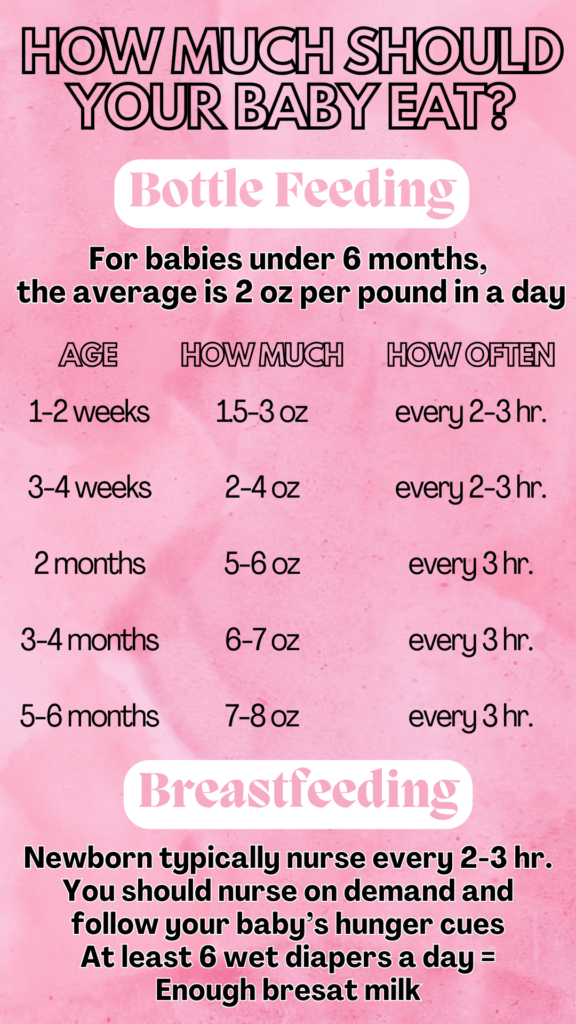One of the most common concerns for new parents is making sure their baby is getting enough to eat. It’s natural to wonder how often your newborn should eat, how much they need, and whether you’re feeding too much or too little. If you’re feeling overwhelmed or unsure, you’re not alone—I’ve been there with both of my babies.
The truth is, there isn’t one perfect schedule that works for every newborn. But understanding typical feeding patterns, signs of hunger and fullness, and how needs change over time can make this journey feel a lot more manageable.
Let’s walk through what to expect during your baby’s first months and how to build a feeding routine that works for both of you.
Pin For Later!

As an Amazon Associate I earn from qualifying purchases. This post may contain affiliate links.
How Much Should a Newborn Eat?
The amount your baby needs depends on their age and whether you’re breastfeeding or formula feeding.
If you’re breastfeeding:
It’s hard to measure exactly how much milk your baby is getting, but if they’re nursing for 10–20 minutes on each side and seem satisfied afterward, that’s a good sign.
In the early days, your newborn’s tummy is tiny, so they’ll only need a few ounces per feeding. In the first hours after birth, newborns benefit from receiving colostrum, a nutrient-rich fluid produced by the mother’s breasts.
Despite their tiny stomach size, colostrum provides essential nutrients and antibodies crucial for their development.
If you’re formula feeding:
Here’s a general guide to formula amounts by age:
- 0–1 week: 1–3 oz every 2–3 hours
- 1–2 weeks: 2–4 oz every 3–4 hours
- 1 month: 4 oz every 4 hours
- 2–4 months: 4–6 oz every 4–5 hours
- 4–6 months: 6–8 oz every 4–6 hours
As always, follow your baby’s hunger cues—they’ll tell you when they’re hungry or full.
How Often Should a Newborn Eat?
In the first month, babies will want to eat every 2-3 hours, or whenever they show baby hunger cues like rooting or sucking on their fists. As they grow, so does their appetite.
By around 5-6 months, they might be chugging down 7-8 ounces per feeding, about 6-8 times a day.
To figure out if your baby’s getting enough to eat, keep an eye on how many wet diapers they go through each day. Ideally, you want to see at least six wet diapers daily. This tells you they’re likely getting the right amount of milk, whether from breastfeeding or formula.
If you notice a big drop in the number of wet diapers or have any worries about feeding, it’s a good idea to chat with your healthcare provider for advice.
How to Know if I’m Overfeeding My Newborn?
While it’s uncommon, overfeeding can happen, especially with bottle-fed babies. Signs of overfeeding include:
- Excessive or projectile spit-up
- Vomiting
- Extreme discomfort after feeds
- Rapid weight gain
To prevent overfeeding, practice responsive feeding by paying attention to baby hunger cues rather than only aiming for a specific number of ounces per day.
Recognizing Hunger Cues
Knowing when to feed your baby involves paying attention to their hunger cues and recognizing when they’re full.
Hunger cues can vary from baby to baby but may include things like smacking lips, sucking on hands, rooting (turning their head toward your hand or breast), or becoming fussy or restless. When you notice these signs, it’s usually a good indicator that your baby is ready to eat.

On the other hand, to recognize when your baby is full, watch for cues like turning away from the breast or bottle, releasing the nipple, or becoming more relaxed and content.
It’s essential to respect your baby’s cues and not force them to continue eating if they seem satisfied. This helps them develop a healthy relationship with food and learn to recognize their own hunger and fullness cues as they grow.
Essential Products for Feeding Your Baby
When it comes to essential products for feeding your baby, having the right gear can make a big difference.
A nursing pillow isn’t just for breastfeeding moms; it’s handy for both breastfed and formula-fed babies. Its benefits extend beyond nursing, providing comfortable support during feeding sessions for both you and your baby.
For breastfeeding moms, a comfy nursing bra is a must-have. Look for ones with soft, stretchy fabric and easy-to-use clasps for quick access during feeding sessions.
I breastfed both my babies, so having a reliable breast pump was super important. I stuck with the same one for both of them – the Spectra Breast Pump. It worked like a charm, I just swapped out the parts when needed.
Nursing pads are also essential to help absorb leaks and keep you feeling dry and comfortable throughout the day.
Another game-changer for breastfeeding moms is the Haakaa cup! It collects milk from the side you’re not feeding from and collects several ounces to store.
For bottle feeding, you’ll need a few key items to get started. Obviously, you’ll need bottles and nipples. Look for bottles that are easy to hold and come in different sizes to accommodate your baby’s growing appetite.
With Emily, I used glass baby bottles, and I swear by them! Check out my comprehensive review of the 9 Best Glass Baby Bottles of 2025 here.
If you’re using formula, be sure to have a supply on hand. And to keep your bottles squeaky clean, invest in a good bottle brush.
And don’t forget to sterilize all parts once a day. A sterilizer ensures that bottles, nipples, and pumping equipment are thoroughly cleaned and free from harmful bacteria, providing peace of mind and promoting your baby’s health.
With these essential products, you’ll be well-equipped to feed your baby comfortably and efficiently, whether you’re breastfeeding or bottle feeding.

Overcoming Common Feeding Challenges
Breastfeeding can come with its fair share of challenges:
- Sore nipples: This is a common issue, especially in the early days of breastfeeding. Ensure your baby is latching correctly to avoid soreness. Use lanolin cream or breast pads to soothe sore nipples between feedings.
- Low milk supply: Some mothers may worry about not producing enough milk. Ensure you’re nursing frequently to stimulate milk production. Consider consulting with a lactation consultant for personalized advice and techniques to increase milk supply, such as power pumping or using a breast pump after feedings.
- Engorgement: Occurs when breasts become overly full and uncomfortable. Nurse frequently and use warm compresses or express milk to relieve engorgement. A cold compress can help reduce swelling and discomfort.
And if you’re formula feeding, you may have all kind of challenges:
- Colic or gas: Formula-fed babies may experience colic or gas, leading to fussiness and discomfort. Try using a formula specifically designed to reduce gas or colic symptoms. Burp your baby frequently during feedings and ensure proper bottle feeding technique to minimize air intake.
- Formula intolerance: Some babies may have difficulty digesting certain types of formula, leading to fussiness, gas, or other digestive issues. Consult with your pediatrician to identify and switch to a formula better suited to your baby’s needs.
- Constipation: Babies may experience constipation, characterized by hard stools or difficulty passing stools. Consider switching to a formula with added prebiotics or probiotics to support digestive health.
No matter how you choose to feed your baby, just know that you’re doing an amazing job.
Seeing those chubby cheeks and happy smiles makes it all worth it.
So, Trust your instincts, listen to your little one’s hunger cues, and don’t be afraid to ask for help when you need it.
I hope this post have addressed some of your concerns regarding feeding your little one.
If you have any further questions, please don’t hesitate to ask in the comments section below.
With love,
Shely




This is an amazing resource for new moms. Thank you for sharing such helpful information.
Thank you Debbie!
Your perspective on life is refreshing! The way you navigate challenges with grace and optimism is truly commendable. Thanks for being a beacon of positivity.
Thanks so much! I’m glad to hear that
I抦 not that much of a internet reader to be honest but your blogs really nice, keep it up! I’ll go ahead and bookmark your site to come back later. Many thanks
Thanks! I’m so glad that you like it 🙂
This website can be a walk-via for all the info you wished about this and didn抰 know who to ask. Glimpse here, and also you抣l definitely uncover it.
Your parenting tips are a lifesaver! Navigating parenthood can be challenging, and your practical advice makes the journey a bit smoother.
Thanks! That is my goal 🙂
whoah this blog is magnificent i love reading your articles. Keep up the great work! You know, lots of people are hunting around for this information, you could help them greatly.
You really make it seem so easy with your presentation but I find this topic to be actually something that I think I would never understand. It seems too complex and extremely broad for me. I am looking forward for your next post, I抣l try to get the hang of it!
I’m still learning from you, while I’m making my way to the top as well. I certainly love reading all that is posted on your blog.Keep the information coming. I liked it!
Thanks! i’m so happy it’s helpfull 🙂
It’s in point of fact a great and useful piece of info.I am glad that you just shared this useful info with us.Please keep us informed like this. Thanks for sharing.
You’re so interesting! I don’t suppose I have read something like this before. So nice to discover another person with a few genuine thoughts on this subject. Seriously.. many thanks for starting this up. This web site is something that’s needed on the web, someone with a little originality!
Very nice post. I just stumbled upon your weblog and wished to say that I’ve really enjoyed browsing your blog posts. After all I’ll be subscribing to your feed and I hope you write again soon!
Thank you! I’m so glad you like it! 🙂